Coronavirus (COVID-19): state of the epidemic - 14 January 2022
This report brings together the different sources of evidence and data about the Covid epidemic to summarise the current situation, why we are at that place, and what is likely to happen next.
This document is part of a collection
State of the Epidemic in Scotland – 14 January 2022
Background
This report summarises the current situation of the Covid-19 epidemic in Scotland. It brings together the different sources of evidence and data about the epidemic in Scotland at this point in time, why we are at that place, and what is likely to happen next. This summarises the data up to and including 12 January 2022 on Covid-19 in Scotland. This updates the previous publication published on 7 January 2022[1]. The information in this document helps the Scottish Government, the health service and the wider public sector respond to the epidemic and put in place what is needed to keep us safe and treat people who have the virus.
This edition of the State of the Epidemic summarises current data on Covid-19 at a national and local level, and how Scotland currently compares to the rest of the UK. It looks at the vaccination program in Scotland and its impact. Information is provided about variants of concern and what impact these may have. Bringing this information together in one place gives the opportunity to better understand the current state of the epidemic in Scotland.
Public Health Scotland (PHS) are aware of larger volumes of tests being processed by laboratories. This and the holiday weekend appears to have impacted turnaround times resulting in delays between specimens being taken and results being received and reported. Public Health Scotland expect variability in reporting of Covid-19 testing data over the festive period due to availability of testing and people presenting for testing. Caution is advised when interpreting this data.
Testing changes
On 5 January 2022, the Scottish Government announced that people who do not have symptoms of Covid-19 will no longer be asked to take a Polymerase Chain Reaction (PCR) test to confirm a positive Lateral Flow Device (LFD) result. Instead, anyone with a positive LFD, who do not have symptoms, should report the result online as soon as the test is done. This means that those without symptoms who previously would have taken a confirmatory PCR test, will no longer do so. As a result, these positive cases are no longer captured in the number of PCR positive cases reported by the Scottish Government and PHS.
In order to ensure that we continue to provide the most accurate information, changes have been made to the national Covid-19 case definition to reflect this revised testing strategy. From Thursday 13 January, the Scottish Government and PHS began reporting on the number of people with a Covid-19 infection confirmed by either a PCR or first LFD positive test, which will be presented as ‘experimental statistics’. These new experimental statistics give us a way to capture both the PCR and LFD positive cases.
We need to be careful how we interpret and compare the number of cases before and after the announcement, so caution is advised.
Due to these recent PCR and LFD testing changes, the State of the Epidemic report this week will summarise case and test data up to and including 12 January 2022. The rest of the analysis will also cover up to and including 12 January 2022 for consistency. We will present analysis incorporating the new experimental statistics in our next report which will be published on 21 January 2022.
The State of the Epidemic Report will continue to include data from the Covid-19 Infection Survey and wastewater analysis (when available), both of which are unaffected by testing policy changes.
Everyone is being encouraged to report their LFD test data so that we can accurately understand and report the prevalence of Covid-19 and allow contacts of those with positive results to rapidly receive the correct advice to prevent onward spread. Please see the blog post for more information about the changes to reporting on Covid-19 cases.
Note on Understanding Covid-19 Test Dates
Different test dates are used when reporting cases and PCR testing data depending on the nature of the data and the use. For rapid surveillance data the reporting date has been used and is included in the figures presented in this report, whereas for detailed surveillance over time the specimen date has been used.
The reporting date is the date that new daily cases are reported by the Scottish Government and Public Health Scotland (PHS), this includes new tests reported to PHS in the previous 24 hours. The time taken for a sample to be processed and provide a result varies and does not indicate the number of samples collected or samples processed on a given day. This is however the most up to date data available.
The specimen date is the date the sample was collected from the patient. Since the time taken to test samples and report the results varies, new cases reported on a daily basis (by reporting date) may be distributed across a range of specimen dates. There is a reporting delay in testing results by specimen date, so data carried out in the most recent 2-3 days will be incomplete and positive tests during the most recent 10 day period may be subject to change. The specimen date data is more accurate and is recommended for interpreting data trends. Data by specimen date is used in the majority of charts and headline figures in this report as it is more suitable for surveillance of Covid-19 over a period of time. In this report the specimen date data has a three day lag, except for comparisons across the 4 nations which has a 5 day lag to account for different data collections across the 4 nations.
Key Points
- The latest R value for Scotland, as of 28 December 2021, was between 1.2 and 1.5, with a growth rate of between 4% and 8%. The lower and upper limits for the R value remain unchanged since the previous week, but the upper growth rate limit has decreased. These figures are based on data to 10 January 2022.
- Latest modelled estimates suggest that, as at 28 December 2021, the incidence of new daily infections in Scotland was between 446 and 674 new infections per 100,000. These figures are based on data to 10 January 2022.
- As determined through the latest weekly ONS infection survey, the percentage of people testing positive for Covid-19 in the private residential population in Scotland has continued to increase in the week 1-7 January 2022, equating to around 1 in 20 people.
- By specimen date, 7 day case rates decreased in Scotland in the week leading up to and including 9 January. There were 1,459 weekly cases per 100,000 population in the week to 9 January 2022, which is a 30% decrease from 2,092 weekly cases per 100,000 in the week leading up to and including 2 January. However, caution must be exercised interpreting these figures following changes to the testing policy.
- As of 9 January 2022, the highest case rates by specimen date were observed amongst those aged 20-39, followed by 40-59, under 20, 60-79 and 80+. However, caution must be exercised interpreting these figures following changes to the testing policy.
- In the week to and including 12 January 2022 Covid-19 hospital occupancy and Covid-19 ICU occupancy (short and long stay) increased by 26% and 32% overall from the previous week.
- Admissions to hospital have fluctuated over the last week, however are at a similar level to the previous week, while ICU admissions have increased by 39%.
- Average hospital admissions (three-week rolling average) related to Covid-19 in children and young adults (aged under 22) have continued to increase overall in the week leading up to 5 January 2022 compared to the previous three-week period leading up to 29 December 2021.
- There were 72 deaths registered where Covid-19 was mentioned on the death certificate in the week to 9 January 2022. This is an increase of 27, or 60%, in the number of deaths from the previous week.
- West Dunbartonshire currently has the highest weekly case rate in Scotland reporting 1,855 weekly cases per 100,000 in the week to 9 January. Shetland has the lowest case rate in Scotland, reporting 608 weekly cases per 100,000 population in the same week.
Method
This report brings together a wide range of publically available figures from a range of data sources. These include publications by Scottish Government, Public Heath Scotland, National Records of Scotland and Office for National Statistics along with scientific publications and SAGE and UKHSA summaries where appropriate to summarise the state of the epidemic in Scotland in a given week. We also provide information on public attitudes to the virus from weekly YouGov polling surveys.
Summary
Estimated Infection Levels
The reproduction number (R) is the average number of secondary infections produced by a single infected person. If R is greater than 1 the epidemic is growing, if R is less than 1 the epidemic is shrinking. The higher R is above 1, the more people 1 infected person infects and so the faster the epidemic grows[2].
The latest R value for Scotland as of 28 December 2021 was between 1.2 and 1.5 (Figure 1)[3] [4]. R is an indicator that lags by two to three weeks and therefore should not be expected to fully reflect the increased prevalence of Omicron in the recent weeks. The R value remains unchanged since the previous week.
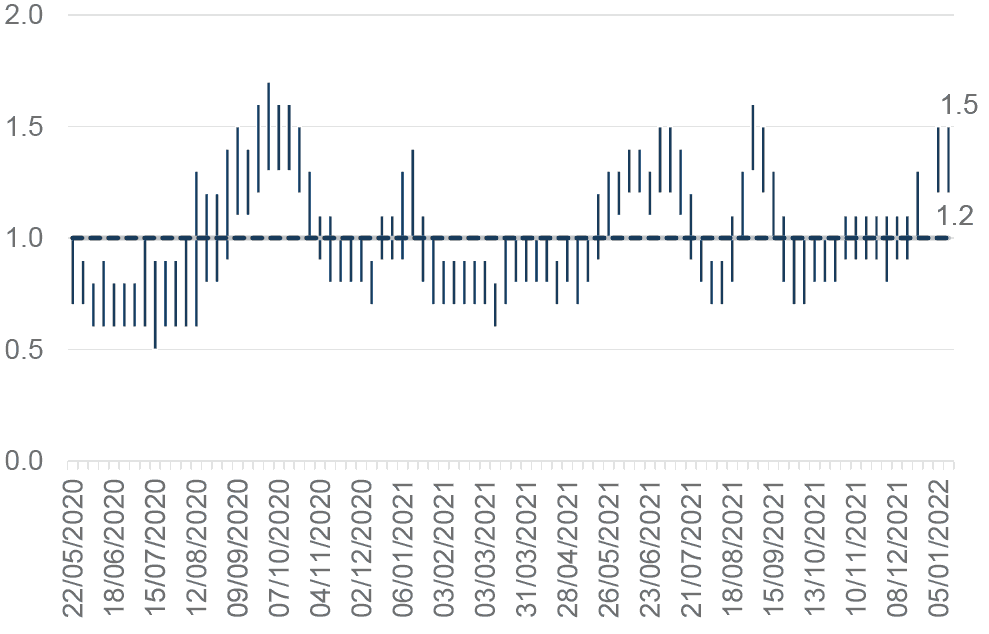
The growth rate reflects how quickly the numbers of infections are changing day by day. It is an approximation of the percentage change in the number of new infections each day.[6] The latest growth rate for Scotland as of 28 December 2021 was between 4% and 8%[7]. The upper growth rate limit has decreased since last week[8].
Latest modelled estimates suggest that, as at 28 December, the incidence of new daily infections in Scotland was between 446 and 674 new infections per 100,000[9] [10]. This equates to between 24,400 and 36,800 people becoming infected each day in Scotland.
Covid Infection Survey
The Covid-19 Infection Survey is a UK wide study carried out by the Office for National Statistics (ONS) and the University of Oxford. The survey invites private residential households to test whether they have the infection, regardless of whether they have symptoms, using a PCR test. Participants are also asked to provide a blood sample to test for antibodies. The study is unaffected by testing policy changes mentioned at the start of this report.
The percentage of people testing positive for Covid-19, in Scotland, in the private residential population continued to increase in the week leading up to 7 January 2022. The estimated percentage of the population living in private residential households testing positive for Covid-19 in Scotland was 5.65% (95% credible interval: 5.06% to 6.27%), equating to around 1 in 20 people. This is higher than the latest peak of 2.29% recorded in the week to 11 September 2021, and higher than the previous peak of 1.24% recorded in the week to 17 July 2021.
In the week 31 December 2021 to 6 January 2022, estimates for the other nations of the UK are as follows and can be seen in Figure 2:
- In England, the trend in the percentage of people testing positive in private residential households has continued to increase in the most recent week: 6.85% (95% credible interval: 6.65% to 7.06%), equating to around 1 in 15 people.
- In Wales, the trend in the percentage of people testing positive in private residential households has continued to increase in the most recent week: 5.56% (95% credible interval: 4.89% to 6.27%), equating to around 1 in 20 people.
- In Northern Ireland, the trend in the percentage of people testing positive in private residential households has continued to increase in the most recent week: 5.41% (95% credible interval: 4.57% to 6.36%), equating to around 1 in 20 people[11].
In Scotland, the percentage of people testing positive for Covid-19 has increased in adults in the most recent few weeks. The trend is uncertain for school age children[12].
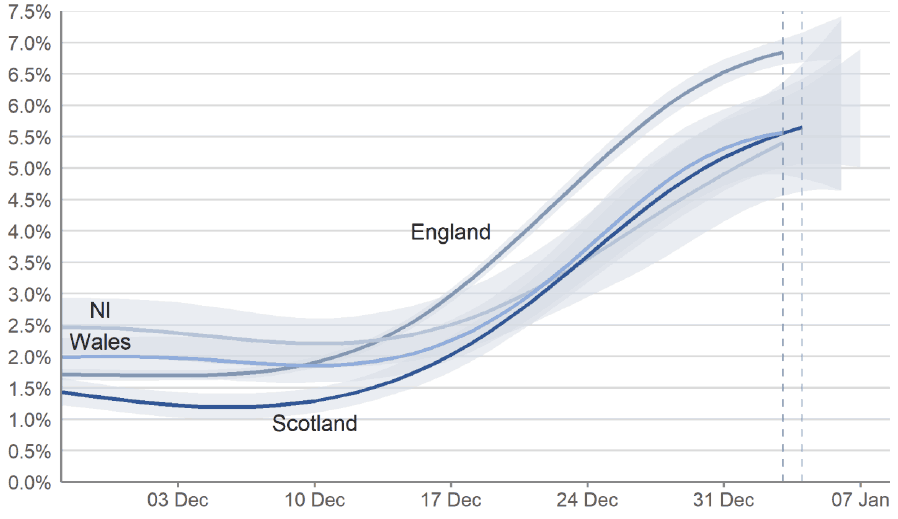
Wastewater Estimates
The Scottish Government has been working with the Scottish Environment Protection Agency (SEPA) to detect and analyse fragments of Covid-19 virus RNA in wastewater. The number of locations where the levels of SARS-CoV-2 in wastewater are monitored has increased to 141 sites around Scotland. In contrast to Covid-19 case records, virus shedding into wastewater is a biological process. This means that wastewater data is unaffected by factors that impact whether testing is done.
We are not including our usual update on Covid-19 levels in wastewater this week, but hope to provide this again in future reports. For wastewater estimates from previous weeks, please see previous reports.
Covid-19 Cases
Please note that due to recent PCR and LFD testing changes, the state of the epidemic report this week summarises case and tests data up to and including 12 January 2022. In addition to the testing policy changes, there continues to be large volumes of tests being processed by laboratories that, in combination with the festive period, have impacted turnaround times resulting in delays between samples beings taken and results being received and reported. Therefore, any comparisons between nations or comparisons over time should be made with caution.
By reporting date[13], an average of 10,833 cases were reported per day in the seven days to 12 January 2022. This a 33% decrease from the daily average of 16,220 cases reported in the seven days to 5 January 2021[14]. In the week leading up to 10 January 2022, Omicron accounts for an excess of 90% of Covid cases. The Omicron variant was originally detected in South Africa and now represents the dominant variant in Scotland. As at 9 January 2022, there were 32,305 confirmed Omicron cases in Scotland[15]. For more information on the emergence of the Omicron variant, see earlier publications.
By specimen date[16], seven day case rates decreased in Scotland in the week leading up to 9 January. There were 1,459 weekly cases per 100,000 population in the week to 9 January 2022, which is a 30% decrease from 2,092 weekly cases per 100,000 on 2 January[17]. However, caution must be exercised interpreting these figures following changes to the testing policy. The seven day case rate as at 9 January remains higher than the most recent peak of 825 weekly cases per 100,000 on 6 September and the previous peak of 425 weekly cases recorded on 3 July (Figure 3).
In the last four weeks up to 7 January 2022, the case rates by reporting date have increased across all vaccine statuses[18].
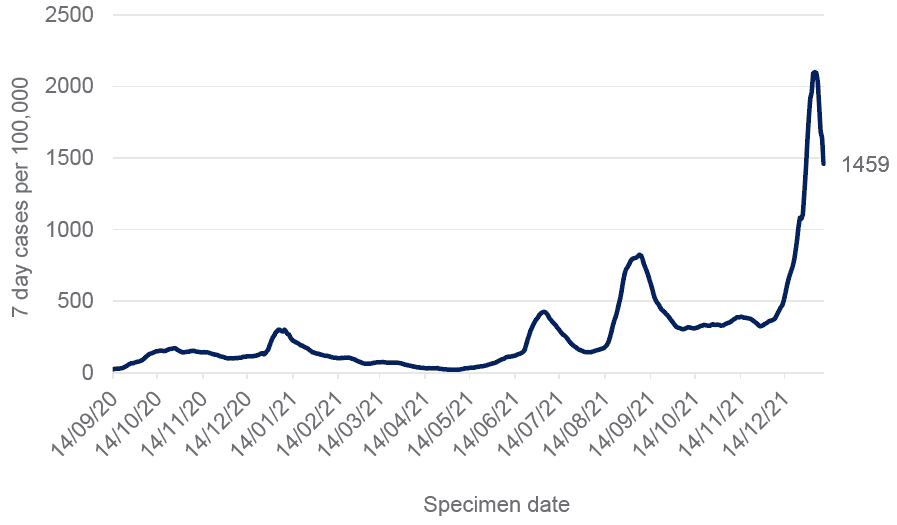
As of 9 January 2022, the highest case rates by specimen date were observed amongst those aged 20-39, followed by 40-59, under 20, 60-79 and 80+ (Figure 4). While case rates decreased in all age groups in the week leading up to 9 January, each age band (except for under 20s) still has a case rate that is higher than its previous peaks. Caution must be exercised interpreting these figures following changes to the testing policy.
The highest case rates by specimen date, amongst children and young people (aged under 22) in the week to 9 January 2022, were observed among those aged 18-19 and 20-21. While case rates decreased among all younger age groups, caution must be exercised interpreting these figures following changes to the testing policy. Those aged 12-15, 16-17, 18-19 and 20-21 continued to have a higher seven day case rate than the Scotland average in this time period[19].
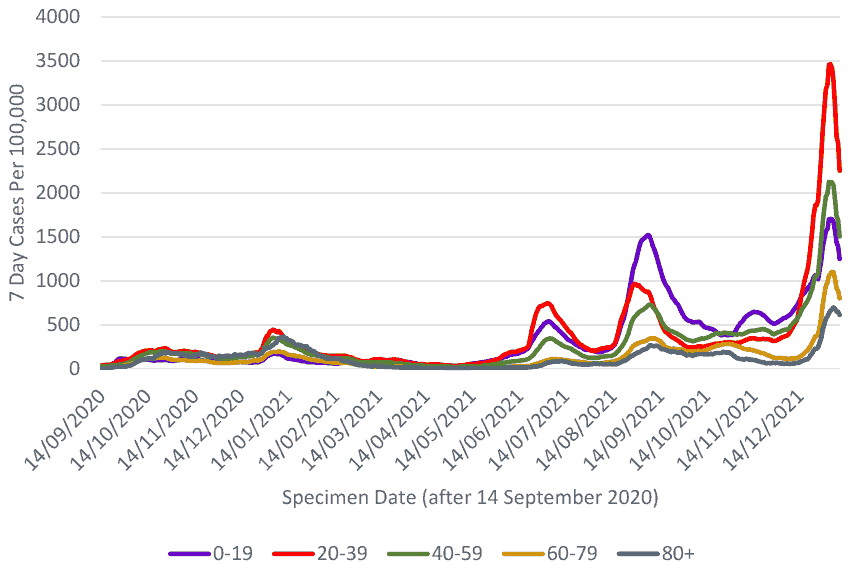
While it may be helpful to compare case rates between the UK nations, any comparisons must at the moment be made with caution due to current data volatility. Please note that UK level cases data includes all positive confirmed PCR test results. In England, cases also include LFD tests that are not followed by a negative PCR test taken within 72 hours.
In Northern Ireland, cases include positive rapid lateral flow tests.
In the seven days leading up to and including 12 January 2022, average daily cases by reporting date in Scotland were 1,982 per one million population. In the same time period, the average daily cases by reporting date were as follows for the other UK nations:
- England: 2,249 per one million
- Northern Ireland: 2,230 per one million
- Wales: 1,929 per one million[21].
By specimen date, Scotland’s seven day average of daily cases per one million was 2,663 in the week leading up to 6 January 2022. For the same period, the other UK nations were as follows:
- Northern Ireland: 3,685 per one million
- Wales: 2,775 per one million
- England: 2,574 per one million[22].
Testing Rates and Positivity
After a period of increase, the seven day total of conducted PCR tests per 1,000 populations peaked at 83 on 7 January, and has since decreased to 68 on 12 January. Showing a similar trend, the proportion of positive PCR tests in the last seven days (test positivity rate), reached 29.4% on 4 January 2022, and decreased to 24.0% on 12 January[23]. However, caution must be exercised interpreting these figures following changes to the testing policy.
There was a 4.3% decrease in LFD tests that were reported in Scotland between 2 to 9 January 2022. This follows a sharp increase in LFD tests that were reported throughout December 2021 which was followed by an 8.9% decrease from 26 December 2021 to 2 January 2022[24].
Scottish Contact Survey asks whether people use Lateral Flow Device tests and if so how often. Approximately 63% of individuals had taken at least one lateral flow test within the last 7 days for the survey pertaining to the 2-8 December. This rose to 86% for the survey pertaining to the 30 December 2021 - 5 January 2022[25].
Hospital and ICU Occupancy and Admissions
NHS boards reported 1,537 patients in hospital on 12 January 2022 with recently confirmed Covid-19, compared to 1,479 on 11 January and 1,223 a week ago (5 January 2022). This is an increase of 314 patients, or 26%, from last week and compares with 2,053 patients in hospital at the peak in January 2021 (Figure 5). ICU occupancy (including short and long stay) has increased to 70 on 12 January, an increase of 17 patients, or 32%, since 5 January, but remains lower than the peak of 172 ICU patients recorded in January 2021 (Figure 5)[26].
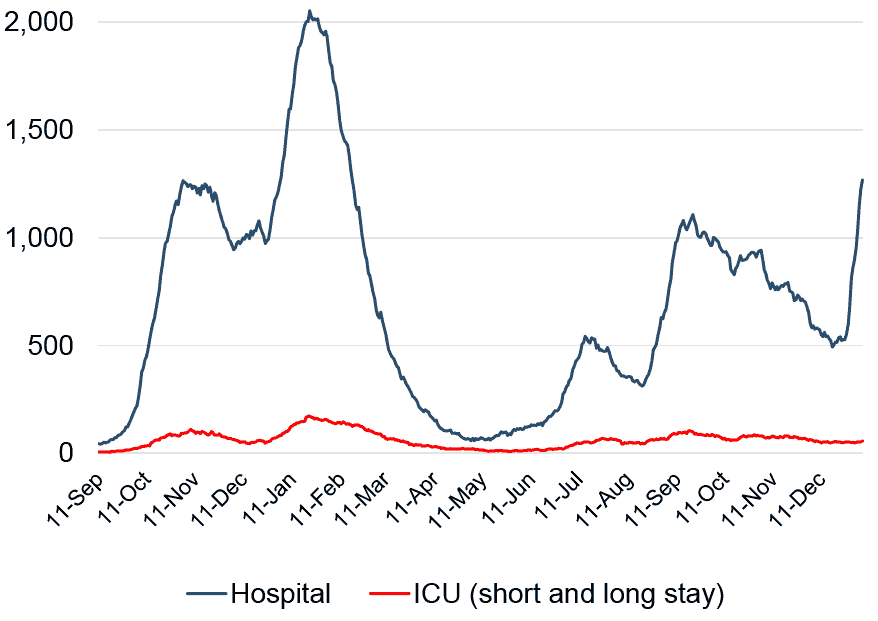
Admissions to hospital have fluctuated over the last week, and are at a similar level to the previous week, with 967 admissions to hospital for people with confirmed Covid-19 in the week to 8 January 2022 compared to 961 in the week to 2 January (Figure 6)[28].
Average hospital admissions (three-week rolling average) related to Covid-19 in children and young adults (aged under 22) have continued to increase overall in the week leading up to 5 January 2022 compared to the previous three-week period leading up to 29 December 2021. The biggest increases in three-week rolling average were seen among those aged 0-1 and 18-19 in the same time period[29]. These figures refer both to young patients in hospital because of Covid-19 and with Covid-19.
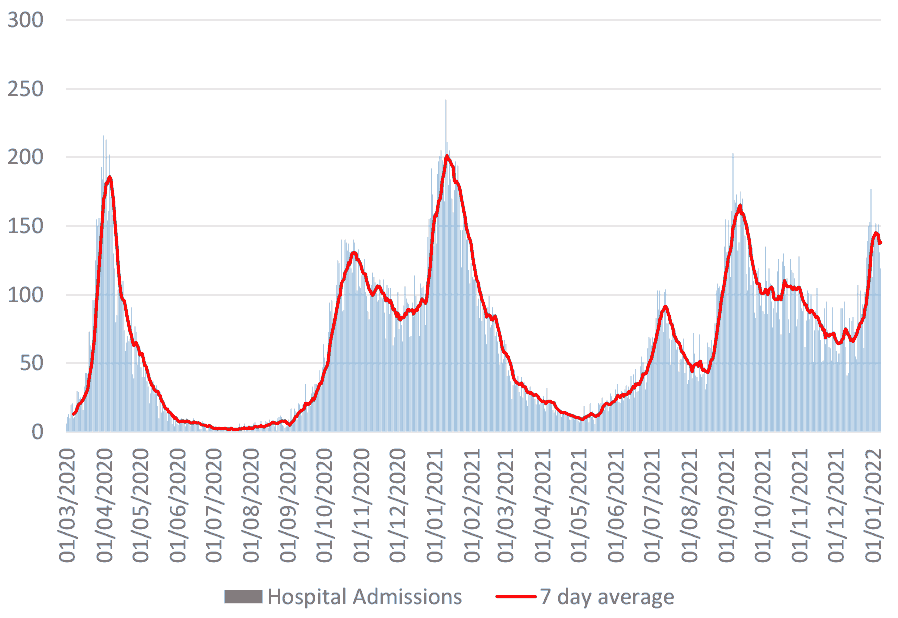
The latest data from PHS shows 43 new Covid-19 patients admitted to ICU in the week to 11 January, compared to 31 in the week to 4 January (Figure 7)[31]. This is a 39% increase in the latest week.
As at 9 January 2022, there were 337 confirmed Omicron related hospital admissions, and 9 confirmed Omicron related ICU/HDU admissions in Scotland[32]. In the four weeks leading up to 7 January 2022, individuals that were unvaccinated were four times more likely to have a Covid-19 related acute hospital admission compared to individuals that had received a booster or third dose of vaccine[33] [34].
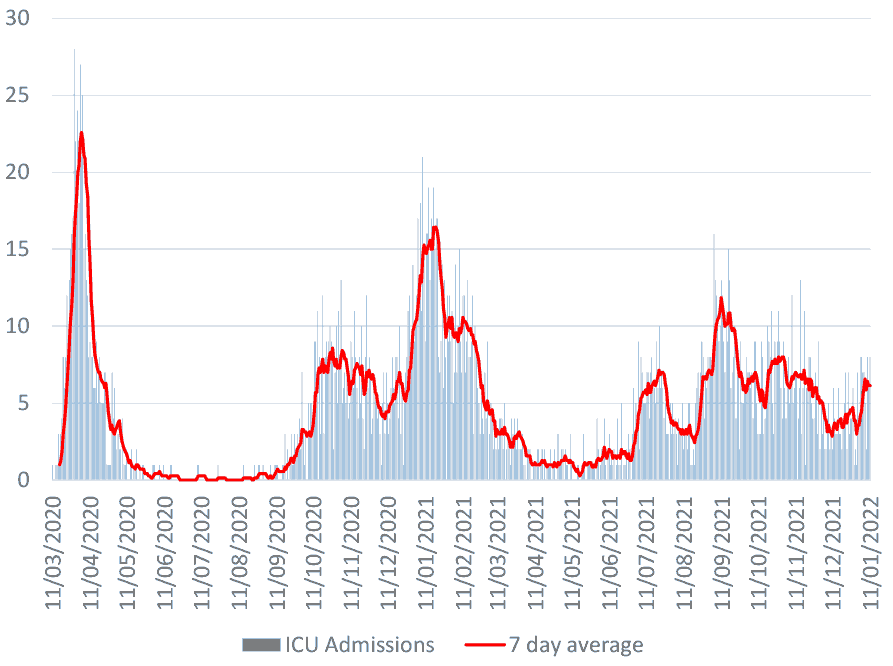
As the population is increasingly vaccinated, more of the patients in hospital will be fully or partially vaccinated. Therefore, it is important that we can differentiate between patients in hospital because of Covid-19 rather than with Covid-19. Public Health Scotland estimates that as at August 2021, 68% of Covid-19 related acute hospital admissions had a primary diagnosis of Covid-19. In March 2021 this figure stood at 75%, and then decreased to a low of 66% in April 2021. This increased to 75% in July, but saw a decrease in August 2021[35].
A clinical audit of case notes shows that as of 2 January 2022 in NHS Greater Glasgow and Clyde and as of 4 January 2022 in NHS Grampian, 60% of acute hospital admissions were ‘because of’ Covid-19 as opposed to coincidental ‘with’ Covid-19. This is lower than the previously reported value of 68% from discharge summaries from NHS boards from between March and August 2021, however these are not directly comparable. Further analysis, based on the clinical audit, showed that 42% of all hospital admissions ‘because of’ Covid were in those aged over 65.
While it may be helpful to compare hospital occupancy between the UK nations, any comparisons must be made with caution. Definitions are not consistent across the nations and data are not reported daily by each nation[36].
There were 19,735 confirmed Covid-19 patients in hospital in the UK on 11 January 2022, which is a 14% increase from 17,354 on 4 January 2022. On the same day,
- 1,479 patients were reported in Scotland, which is a 28% increase from 1,152 on 4 January 2022,
- 16,939 patients were reported in England, which is a 13% increase from 15,044 on 4 January 2022,
- 878 patients were reported in Wales, which is a 30% increase from 677 on 4 January 2022, and
- 439 patients were reported in Northern Ireland which is a 9% decrease from 481 on 4 January 2022)[37].
This translates to 29 patients per 100,000 population for England, and 25 patients per 100,000 in Scotland, Wales as well as Northern Ireland (based on seven day averages for all 4 nations), as of 11 January 2022.
Deaths
There were 72 deaths registered where Covid-19 was mentioned on the death certificate in the week to 9 January 2022. This is an increase of 27, or 60%, from the 45 deaths reported the previous week, but 89% lower than the peak in April 2020 (663 deaths)[38]. As at 9 January 2022, there were 15 confirmed Omicron related deaths in Scotland[39].
In the week to 9 January 2022, deaths involving coronavirus decreased in the age group 45-64, but remained unchanged or increased in all other age groups compared to the week before (ending 2 January) (Figure 8). The biggest increase in death numbers was seen among those aged over 85, with 25 Covid related deaths having occurred in the week to 9 January compared with 8 the week before. National Records of Scotland publish a weekly detailed analysis on deaths involving Covid-19 in Scotland in their weekly report[40].
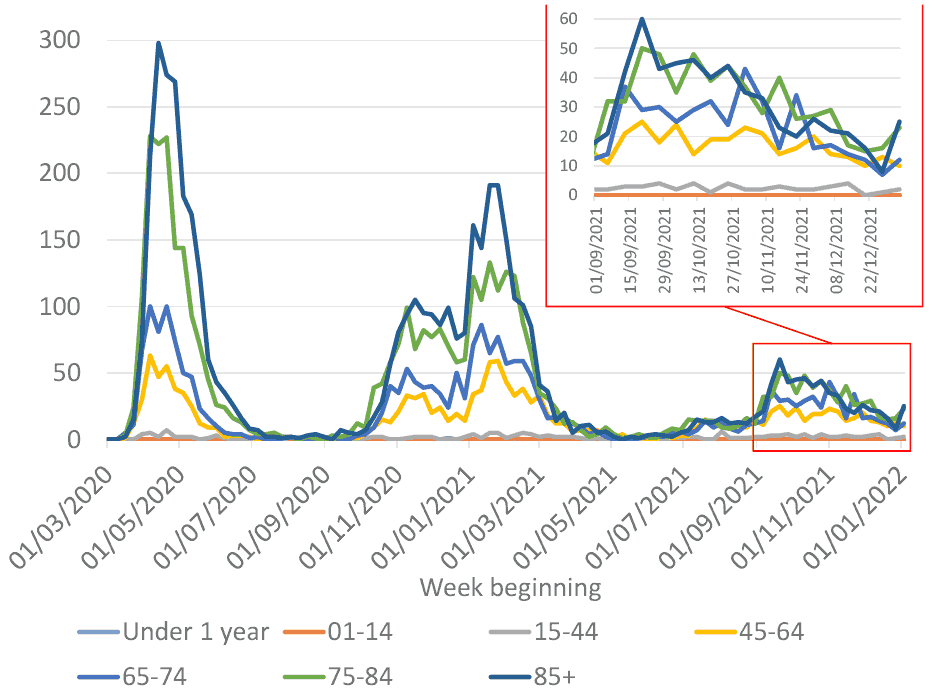
While it may be helpful to compare deaths between the UK nations, any comparisons must be made with caution. Death definitions are not consistent across the nations.
There were 3 average daily deaths in Scotland per 1 million people in the week to 12 January. Average daily deaths per 1 million population in the same period for other UK nations were as follows:
- England: 4 per 1 million population
- Wales: 3 per 1 million population
- Northern Ireland: 2 per 1 million population[41].
Vaccinations
The first vaccines were administered on Tuesday 1 December 2020 and by 11 January 2022 almost 4.4 million people (91.7% of those aged 12+) had received their first dose and over 4 million people (84.8% of those aged 12+) had received their second dose[42]. There remains a low level of deaths amongst vaccinated individuals.
A booster dose or a third dose of the vaccine is now available in Scotland, in line with JCVI advice including all adults aged over 18 for whom it has been at least 12 weeks since their second dose. Over 3.1 million people (65.8% of those over 12 years of age) have received their dose 3 or booster vaccine by 11 January 2022[43].
Booster vaccine uptake is at least 91% amongst males and females aged 60 or over, and around 87% for males and females aged 55-59. However, there is a difference between male and female vaccine uptake in those aged between 18 and 49 with females showing a higher uptake compared to males (Figure 9).
PHS estimated in an analysis published on 25 November that 27,656 deaths in people 60 years and older have been directly averted as a result of Scotland’s Covid-19 vaccination programme. This equates to an estimated 86% of deaths averted by vaccination in this age group[44].
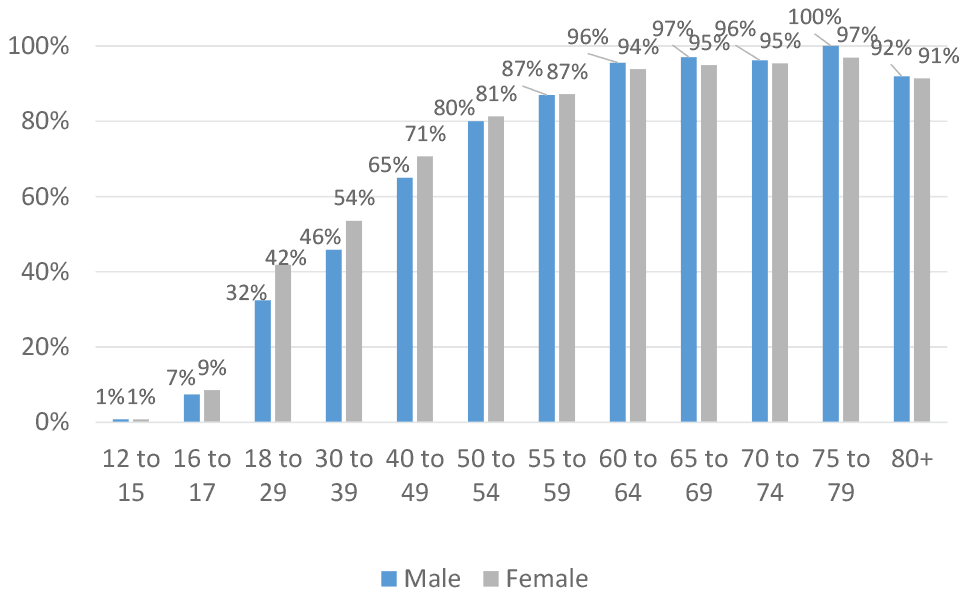
Antibodies Estimates
The ONS Covid-19 Infection Survey estimated that in the week beginning 20 December 2021, 97.7%[45] of the adult population living in private residential households in Scotland would have tested positive for antibodies against SARS-CoV-2 at the standard threshold, as a result of having the infection in the past or being vaccinated. This compares to:
- 97.5% in England (95% CI: 97.0% to 97.9%),
- 96.8% in Wales (95% CI: 95.9% to 97.5%),
- 97.4% in Northern Ireland (95% CI: 96.0% to 98.2%)[46].
The percentage of adults aged 16 and over testing positive for antibodies ranged from 96.4% to 99.1%. The highest percentage of people testing positive for antibodies was in those aged 65 to 69 at 99.1% (95% credible interval: 98.5% to 99.4%), followed by those aged 70 to 74[47].
Omicron variant
The latest Omicron risk assessment carried out by the UK Health Security Agency (UKHSA), established with high confidence from analysis of UK data that Omicron is showing increased household transmission risk, increased secondary attack rates and substantially increased growth rates compared to Delta, the previously dominant variant. There is also high confidence that Omicron displays a reduction in immune protection against infection. Omicron infections have a reduced risk of hospitalisation (low confidence)[48].
The UKHSA reported that vaccine effectiveness against symptomatic disease with the Omicron variant is lower compared to the Delta variant and wanes rapidly. For 2 doses of AstraZeneca, effectiveness against symptomatic disease dropped from 45 to 50% to almost no effect against Omicron from 20 weeks after the second dose. For 2 doses of Pfizer or Moderna effectiveness against symptomatic disease dropped from around 65 to 70% down to around 10% by 20 weeks after the 2nd dose. Between 2 to 4 weeks after a booster dose vaccine effectiveness against symptomatic infection ranged from around 65 to 75%, dropping to 55 to 65% at 5 to 9 weeks and 45 to 50% from 10+ weeks after the booster [49] [50] .
However, vaccine effectiveness against hospitalisation is high, preliminary estimated at 88% (78 to 93%) for Omicron after 3 doses of vaccine dropping to 83% 10+ weeks after a booster dose[51] [52]. More data is needed to estimate the duration of vaccine effectiveness against hospitalisation over time.
There is evidence that there is reduced overall risk of hospitalisation for Omicron compared to Delta[53] [54], with the most recent estimate of the risk of presentation to emergency care or hospital admission with Omicron was approximately half of that for Delta[55].
Situation by local authority within Scotland
Please note that due to recent PCR and LFD testing changes, the state of the epidemic report this week summarises case and tests data up to and including 12 January 2022. In addition to the testing policy changes, there continues to be large volumes of tests being processed by labs that, in combination with the festive period, have impacted turnaround times resulting in delays between samples beings taken and results being received and reported. Therefore, any comparisons between local authorities or comparisons over time should be made with caution.
Case rates have decreased in Scotland over the past week, with all local authorities seeing a decreasing case rate over the week leading up to 9 January 2022. West Dunbartonshire currently has the highest weekly case rate in Scotland reporting 1,855 weekly cases per 100,000 in the week to 9 January. Shetland has the lowest case rate in Scotland, reporting 608 weekly cases per 100,000 population in the same week (Figure 10 and Table 1)[56].
| Local authority | Total new cases in the week, per 100,000 population | Change since previous week |
|---|---|---|
| West Dunbartonshire | 1,855 | -500 |
| South Lanarkshire | 1,851 | -871 |
| Inverclyde | 1,835 | -960 |
| Renfrewshire | 1,712 | -995 |
| North Lanarkshire | 1,661 | -1073 |
| North Ayrshire | 1,601 | -493 |
| East Renfrewshire | 1,592 | -866 |
| Glasgow City | 1,569 | -690 |
| Falkirk | 1,565 | -519 |
| East Ayrshire | 1,521 | -852 |
| Fife | 1,470 | -365 |
| Moray | 1,464 | -983 |
| Clackmannanshire | 1,457 | -421 |
| Dumfries and Galloway | 1,449 | -663 |
| South Ayrshire | 1,437 | -622 |
| Angus | 1,424 | -232 |
| East Dunbartonshire | 1,411 | -950 |
| Aberdeen City | 1,401 | -328 |
| Perth and Kinross | 1,387 | -413 |
| Dundee City | 1,370 | -469 |
| East Lothian | 1,345 | -373 |
| City of Edinburgh | 1,341 | -549 |
| Stirling | 1,340 | -599 |
| West Lothian | 1,325 | -833 |
| Midlothian | 1,275 | -670 |
| Highland | 1,180 | -558 |
| Aberdeenshire | 1,169 | -363 |
| Argyll and Bute | 1,084 | -233 |
| Scottish Borders | 1,003 | -770 |
| Orkney Islands | 692 | -545 |
| Na h-Eileanan Siar | 615 | -336 |
| Shetland Islands | 608 | -61 |
| Scotland | 1,459 | -633 |
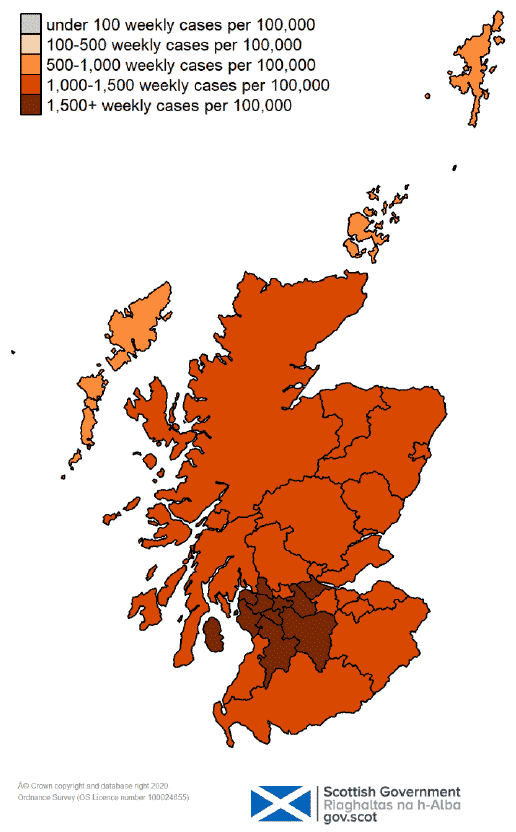
Please note that the local authority hotspot modelling continues to be based on Covid-19 cases and deaths using data to 10 January 2022 from several academic groups to give an indication of whether a local authority is likely to experience high levels of Covid-19 in the future. This has not been compiled via UKHSA into a consensus this week and is based on one modelling group. The increased uncertainty due to differences in case reporting over Christmas is less influential in the modelled estimates this week. However, many Scottish regions are at what could be a turning point in case data. Turning points are detected to different degrees by the modelling.
Modelled rates of positive tests per 100,000 population indicate that, for the week commencing 23 January 2022, 29 of the 32 local authorities are expected to exceed 50 cases per 100,000 population with at least 75% probability[57]. The exceptions are Na h-Eileanan Siar, Orkney Islands and Shetland. The same 29 local authorities are also expected to exceed 100 cases per 100K with at least 75% probability.
23 local authorities are expected to exceed 300 cases per 100,000 people with at least 75% probability. These are: Aberdeen City, Aberdeenshire, Angus, Argyll and Bute, Clackmannanshire, Dumfries & Galloway, Dundee City, East Ayrshire, East Lothian, East Renfrewshire, Falkirk, Fife, Glasgow City, Inverclyde, Midlothian, Moray, North Ayrshire, Perth & Kinross, Renfrewshire, South Ayrshire, South Lanarkshire, Stirling and West Dunbartonshire.
Angus, Clackmannanshire, Fife, North Ayrshire, Perth and Kinross, and West Dunbartonshire are expected to exceed 500 cases per 100,000 with at least 75% probability[58].
Looking ahead
Scottish Contact Survey
Changes in patterns of mixing and adherence to restrictions will impact on future case numbers. The Scottish Contact Survey measures times and settings that people mix where they could potentially spread Covid-19. Average contacts from the most recent Panel B cohort of the Scottish Contact Survey (week ending 5 January) indicate an average of 3.7 contacts.
Mean contacts have decreased within the work and other setting (contacts outside home, school and work) reducing by 32% and 18% respectively. Contacts within the home have increased by 9% over the same period.
All age groups, with the exception of those aged 18-29, have decreased their contacts. This is largely driven by a reduction in contacts within the work and other setting. The 18-29 age group have reported a similar level of contacts in the last two weeks.
Self-reported compliance with the current regulations and guidance has decreased since January but remains at a high level. On 4-5 January, 69% of people reported ‘complete’ or ‘almost complete’ compliance[59].
Modelling the Epidemic
The latest Modelling the Epidemic report shows estimated number of infections, including projections over the four weeks to beginning of February for combined Delta and Omicron infections. Delta infections are likely to fall over time based on the current level of restrictions, but those still being infected and already infected will still contribute to the numbers of people in hospital and ICU. Meanwhile the future trajectory of infections is highly uncertain. For hospitalisations, occupancy and deaths, disruption to data flows and behaviour changes over the festive period makes it difficult to interpret recent trends in the data.
Long Covid
Over the four-week period ending 6 December 2021, an estimated 1,266,000 people (95% confidence interval: 1,228,000 to 1,304,000) in the private residential population in the UK (1.96%; 95% CI: 1.90% to 2.02%) reported experiencing long Covid (symptoms persisting more than four weeks after the first suspected coronavirus (Covid-19) episode that are not explained by something else). In Scotland, over the same period, an estimated 100,000 people (1.90% of the respective population) in the private residential population reported experiencing long Covid of any duration. This compares to 1.98% in England, 1.91% in Wales and 1.57% in Northern Ireland[60].
Modelling of long Covid estimates that at 30 January 2022 between 64,000 (1.2% of the population) and 160,000 (2.9%) people are projected to self-classify with long Covid for 12 weeks or more after their first suspected Covid infection in Scotland[61].
Next steps
The Scottish Government continues to work closely with Public Health Scotland and modelling groups to monitor what is happening across Scotland.
Each week this report will provide an overview of the current Covid-19 situation in Scotland. This will include real time data on case rates, hospitalisations and deaths and how Scotland’s figures compare to those from the rest of the UK.
Modelling can tell us where the epidemic is likely to be heading. Local data and data by age group can highlight where problems arise, which can help in addressing some of these issues. In the coming weeks the roll out of the vaccine will continue to be monitored along with the impact of this on case rates and deaths among different age cohorts. Investigations are ongoing by NERVTAG, SPI-M, SAGE, UKHSA, Public Health England and Public Health Scotland regarding the impact of new variants and of vaccination; this will be reflected here as work is undertaken.
Contact
There is a problem
Thanks for your feedback